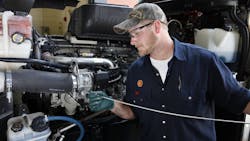It’s getting harder to secure new—and even used—trucks as supply chain problems and other ripples from the COVID-19 pandemic slow down new vehicle production. Some industry analysts warn that a new truck ordered today might not roll off the assembly line until later in 2022. “Downtime is to be avoided at all costs these days,” Karin Haumann, OEM technical manager at Shell Global Solutions, said.
“In the environment that we have today in the trucking industry, it’s especially important to be able to maximize the amount of time that the vehicles are on the road,” Haumann told FleetOwner. “An oil analysis program helps you have confidence that your truck and your fleet is healthy—and your maintenance schedules are adequate and not excessive.”
The more a fleet knows about its engine fluids, the more powerful its maintenance schedule can be. “You want to be able to use the whole life of the oil,” Haumann said. “Sometimes it’s better for fleets to learn how they can shorten their drain interval a little bit to coordinate it with some other scheduled maintenance so they’re reducing the number of times a vehicle is down.”
Getting the latest analysis on vehicle oil can keep fleets up to date on trends that have developed over time and highlight any anomalies along with recommendations for maintenance, according to Darryl Purificati, a spokesperson for Petro-Canada Lubricants and HollyFrontier Lubricants & Specialties.
“Analyzing the condition of your fleet’s used engine oil is a simple three-step process to produce a report which can inform your decisions,” he told FleetOwner. “The first step is to take a representative sample of the engine oil. Second, the sample should be sent to a qualified used oil analysis laboratory. The final and most important stage is interpreting and acting on the findings of the report to improve the performance and reliability of your fleet.”
Ft. Wayne, Indiana-based Blackstone Laboratories tests all types of oils for engines, industrial equipment, generators, and aircraft. “Diesel engines are a big part of our market and one of the things we specialize in,” Ryan Stark, Blackstone president, told FleetOwner.
Stark said the analysis of oil hasn’t changed much since his father founded Blackstone Labs in 1985. “What we do is known as standard analysis, which is a package that we developed that pretty much gives our customers the most information for the money,” he said.
That standard analysis, Stark explained, “covers all the major problems that can happen. The first test is the spectral analysis, where we test all the different elements present in the oil and that covers wear metals, additives, and contaminants that might get in the oil like silicon, sodium, or antifreeze. We also do a flashpoint on the oil, which tells us about fuel dilution. If the flashpoint is significantly lower, then you’ve got fuel dilution, and this could be a sign of something like a bad injector or fuel pump.”
Stark explained that diesel engines could struggle when contaminants get mixed in from a leaky injector or bad pump. It could be antifreeze getting into the oil from the oil cooler. Blackstone, like other labs, also tests the viscosity of the oil to see if it’s thicker than it should be. Oil can thicken up and make the engine unserviceable, he warned.
Sample the fleet
Shell’s Haumann suggests selecting a sample of vehicles within a fleet to analyze regularly. “It’s not necessary to do it on every truck,” she said. “But on the trucks that are selected, we would typically do an oil analysis on every oil drain. So, throughout the life of the engine, you’re getting feedback on what the oil looks like after the end of its use, which gives you feedback on the condition of the engine, the condition of the oil, life left in the oil, whether the drain has been overextended, or whether the drain interval can be extended in certain circumstances, given the data.”
How many vehicles to choose for regular fluid analysis depends on the fleet size and the range of duty cycles, Haumann said. “What we would recommend is to do a really good thorough analysis of the fleet and choose what we call the worst-case scenario vehicles so you can extrapolate those data to trucks that you are not sampling,” she explained. “You want to take the harshest duty cycle on a set of engines.”
Haumann said to keep in mind a fleet’s various engines. “You want to be sampling from each engine manufacturer if operating a mixed fleet,” she said.
Take into account the age of the engines in the fleet, if they were rebuilt, their duty cycles, and operating environment. “You take the harshest scenarios and analyze those at every oil change,” Haumann said. “Then you can extrapolate that data and be comfortable that you’re testing your worst-case environment. So when you set your oil drain interval based on those, you know that the other engines are at least in a better situation and at least as protected.”
Oil companies and engine manufacturers have “collected gobs of data on engine oil in different scenarios and use at different lengths,” Haumann said. “Through the analysis, we can see things like how much of the additive package is still active and available; how quickly the oil is aging; how much life is left in the oil, based on oxidation level—there’s a condemning limit for oxidation and nitration.”
Analyzing the analysis
Blackstone Labs’ analysis reports come with “a fairly extensive comments section, where we go through and try to explain in plain English exactly what we see,” Stark said. “We’ll go through and tell them if everything looks good or if it looks like there’s a problem. And we’ll talk about what we think the problem might be and what kinds of steps there are to remedy it.”
Suggested remedies could be having the engine looked at more closely or checking at shorter oil intervals to see if the problems are getting worse, Stark explained.
The analysis can also show the engine’s health based on wear metals, indicating unwanted wear in the engine, Haumann noted. Engine wear coupled with contaminants such as soot and fuel dilution show how much life is left in the oil.
“Those types of things can help you understand if there’s life still left in the oil,” she said. “What we typically do is we’ll take the standard OEM recommendation for oil drain interval based on the engine, duty cycle, and fuel economy and then test the oil. If we can see that there’s still life in the oil, we will increment that drain interval by 20%, and then we test it again. If there’s still life in the oil, we’ll increment it another 20%. And we’ll do that until we get to a point where we’ll say, ‘OK, wait a minute. It looks like we’re coming to the end of the useful life of the oil—or there are some contaminants that we don’t like to see.’ So, we’ll back it down to the last increment, and we’ll set that as your drain interval.”
Stark explained that regular oil analysis is integral to any preventive maintenance program. Regular oil testing at the proper drain interval can show an engine’s pattern throughout its life and show fleets how that engine is aging. This process can’t predict a catastrophic engine event, but based on the metal properties of the engine, it can show if there is wear in the ring or liners.
“When you see those wear metals present in the oil, you can get an indication that you’ve got an issue there either because the drain has been overextended or there have been some other issues with the engine,” Haumann said.
This oil analysis, coupled with other maintenance practices, can help fleets pinpoint if trucks may have a mechanical problem. “For instance, if you have really high soot, that can be an indication that you’ve got an issue with combustion, with injection timing, or a lack of intake air,” Haumann said. “It can guide you where to look if you might be having mechanical issues.”
Shell always recommends fleets follow OEM recommendations for fluids. “The OEM recommendation is segmented by duty cycle,” Haumann explained. “They call it the different buckets, and it’s typically gauged by fuel economy—indicating how hard you’re working the engine.”
Following those OEM recommendations also ties into truck warranties, allowing for some extended drain intervals when combined with regular analysis.
“Some of the OEMs—in certain duty cycles—allow you to extend the drain interval,” Haumann said. “They will give a number of miles in a certain situation, and they’ll say you can extend it from x number of miles to y. With an engine oil analysis program, as long as you are looking at the oil through this extension period, the OEMs will still honor the warranty to an extended drain period as long as you are monitoring the oil.”
Haumann suggests designating someone to monitor analysis data for trends, which can help with preventive maintenance.
Ideal samples
“It is good to get a baseline on the engines when they’re normal,” Stark advised, “so fleets have something to compare to when things aren’t normal, and they are able to tell what’s changed.
Haumann also suggested analyzing unused oil to set up a benchmark. “Different oils have different chemistries with different total base numbers and components,” she said. “Some of the components that we employ in engine oil additives actually are present in the metallurgy of some of the engines and may appear as wear metals. You really need to understand, when you get these oil analyses back, what it is that you’re looking at.”
For the sample sent to the lab, it’s best to use a sample valve, Haumann said, “because you want to make sure that you’re pulling a sample that’s representative of the oil flowing through the engine. If you pull it from the pan, you may have some settling of some contaminants in the bottom of the pan, and it might not be representative of the homogenous oil in the engine.”
Warning signs
When looking for particular warning signs in oil analysis, it can get “quite complex,” Haumann said, because one component found in an analyzed sample could be tied to other parts. “The basics are you’re looking at viscosity. Oxidation and nitration show you how the oil is aging. The base number indicates the additive package and the health of the additive package, which depletes over time. There’s typically a low condemnation limit on the total base number. Once you get below a certain level, then you realize that there’s not enough of the additive package left.”
Another thing to look out for is contaminants such as soot and fuel dilution. “These go hand in hand,” Haumann said. “You can have your viscosity increase with high soot. You can have your viscosity decrease, but you’ve got high fuel dilution. Then it’s not necessarily the oil but a fuel dilution issue that you’re seeing.”
Fleets should also be on the lookout for wear metals in their analysis, such as iron, lead, copper, chromium, and aluminum. Finally, fleets that collect data over the life of an engine not only benefit from performance, but also from an increase in the vehicle’s resale value, Haumann pointed out. FO
Sidebars
Petro-Canada provided FleetOwner these details on understanding used oil analysis:
● Analyzing the condition of a fleet’s used engine oil is a three-step process to produce a report that can inform service decisions. The first step is to take a representative sample of the engine oil. Second, the sample should be sent to a qualified used oil analysis laboratory. The final and most crucial stage is interpreting and acting on the report’s findings to improve the performance and reliability of the fleet.
● The data provided in a used oil analysis report can also offer operators the potential to extend oil drain intervals, providing another effective method for reducing maintenance costs.
● When working with a specialized oil provider, experts will evaluate the trends that have developed over time and highlight any anomalies along with recommendations for maintenance.
● It is also valuable for fleet owners and operators to interpret used-oil analysis results and correctly identify their causes. The maintenance team will then become familiar with a ‘normal’ reading for their fleets.
Common anomalies and early warning signs to look for include:
● Coolant or glycol present could be the sign of a failing exhaust gas recirculation (EGR) cooler seal. The first sign of this is reports of silicon, potassium, or sodium in the oil analysis, so levels of these properties should be watched closely as a failing EGR cooler seal requires immediate attention from a technician.
● Increases in iron and aluminum can be early indicators of a failing camshaft, coolant leak attacking the liners, or the engine requiring mechanical adjustment.
● Unburnt fuel (as a result of fuel dilution and reduction in viscosity) and increases in metals (iron, aluminum, lead, and copper) are indicators that the protection of engine components may be compromised.
About the Author
Josh Fisher
Editor-in-Chief
Editor-in-Chief Josh Fisher has been with FleetOwner since 2017. He covers everything from modern fleet management to operational efficiency, artificial intelligence, autonomous trucking, alternative fuels and powertrains, regulations, and emerging transportation technology. Based in Maryland, he writes the Lane Shift Ahead column about the changing North American transportation landscape.




